
|
Sale 78
January Pre-Long Beach Sale 17.5% BP
| Lot |
Photo |
Description |
Realized |
Lot 1763 |
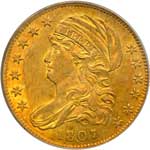 |
1807. Bust left. BD-7. Rarity 5+. PCGS graded MS-60. Well struck and bursting with deep golden-orange luster and rose-color highlights. Housed in an Old Green Holder. Only 51,605 struck.
Banks and bullion houses continued to hoard and melt this new Capped Draped Bust Left issue of 1807 to the same extent or more as all of the old tenor gold coins (pre-1834). The mintage figures for these years can be determined with a greater degree of accuracy than those prior, but the Mint still employed dies in years othe rthan the dates on them.
This new type was the result of hiring John Reich as an assistant engraver. His new design with a floppy cap has traditionally been called Capped Bust, but the previous type by Robert Scot (1795-1807) also has a capped bust. This design also has drapery, so the nomenclature has been confusing. The definitive difference is the direction Liberty is facing. The previous type has her facing right, while this type has her facing left.
Not as many dies were required for this type compared to the previous ones. This is because the Mint had improved die life through a series of innovations in their die preparation process.
This obverse paired with a second reverse creates the other variety, so the reverse die used here failed. The cracks noted by Dannreuther places this in the intermediate state "b" for the reverse and state "b" for the obverse because the dies clashed.
As Dannreuther confirms, "The die production procedures had improved so dramatically from the earliest days of the Mint that some dies (the next reverse, for example) were lasting for nearly 100,000 strikings. The simplified design of this type versus the previous one may also have contributed to longer die life. Intricate designs cause greater stress on dies, leading to cracking and other injuries. Clashing was still prevalent, but the simpler designs had fewer areas of conflict.
A delightful first-year coin with abundant mint frostiness covering both sides. Suitable for an advanced collection of early United States Half Eagles (PCGS # 8101) .
Estimated Value $10,000 - 12,000.
View details and enlarged photos
Check results on similar lots
| Realized
$16,450 |
Lot 1764 |
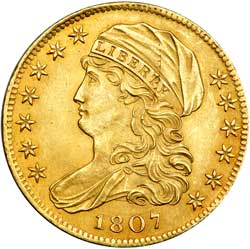 |
1807. Bust Left PCGS graded Unc Details. BD-8, Rarity-2. Filed rims. Well struck with rich frosty mint luster completely intact. Delicate sunset golden mint bloom adds to its appeal.
This variety is by far the most seen variety of the two for 1807. On the reverse, the feather tip points to the tip of the 5 (in BD-7 it points to the center of the flag of the 5). Approximately 500 to 700 believed to be extant, Rarity-2 per Dannreuther.
Note in the photographs that there is a small chip out of the 13th star's point that is nearest to the rim denticles. It is widely believed that John Reich, designer of the Capped Draped Bust pieces of 1807-12 "signed" his dies by using the star in the final position with a small notch on the outer point facing the rim. He resigned his Mint post in 1817 after his request for a pay raise was denied. On coins of all denominations struck after 1817, including the Half Eagles, the mysterious notch no longer appears (PCGS # 8101) .
Estimated Value $5,000-UP.
The Del Valle Collection.
View details and enlarged photos
Check results on similar lots
| Realized
$12,338 |
Lot 1765 |
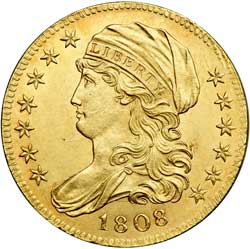 |
1808 BD-4 Rarity 3+ NGC graded Unc Details. Obverse spot removed. A well struck example shimmering with intense frosty mint luster with hints of delicate golden overtones. We note some fine hairline scratches above star 8 (1 o'clock) that is the probable reason this beauty did not grade MS63 or MS64.
Distinguished by the Wide 5 D on reverse. Normal 8 with close date, arced. Survival estimate: 175 to 225 pieces, Rarity-3+. According to Dannreuther, "this variety is the first early gold coin that seems to have a single die state for both dies for the entire production run. Because it is estimated that possibly 20,000 of this variety were struck, this is remarkable." The reverse die also was used for the next year�s issue, the lone variety of 1809,an overdated leftover 1808 die. "Because the 1809/8 issue is much more difficult to locate than this variety, it is likely that some of the reported mintage for the calendar year 1809 was dated 1808 -- and those coins probably were this variety." (PCGS # 8102) .
Estimated Value $5,000-UP.
The Del Valle Collection.
View details and enlarged photos
Check results on similar lots
| Realized
$10,223 |
Lot 1766 |
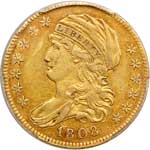 |
1808. PCGS graded EF-45. Nicely toned. Only 55,578 struck. A few light circulation marks in the fields and on devices, choice rims are free of bruises, which is always beneficial. Well balanced toning over both sides provides a good deal of aesthetic appeal.
In 1807, following the coinage of some of the old-style Heraldic Eagle pieces, the mint�s engraver John Reich redesigned the Half Eagle. The new style is the forerunner of that adopted a year later for the Quarter Eagle. The obverse depicts Liberty facing left, wearing a cloth cap inscribed LIBERTY, with seven stars to the left and six to the right. (Similar looking designs appear on the minor denominations from 1807-38: Half Dollars, Quarters, Dimes, and, in 1829, Half Dimes.)
The reverse shows an eagle perched on a palm branch, holding three arrows, with the motto E PLURIBUS UNUM on a ribbon or band above. The legend UNITED STATES OF AMERICA, 5 D. surrounds.
This new Half Eagle format was continued through 1812. The brief span of this design yielded a coinage estimated at 399,013 pieces. Most were subsequently melted. Estimates range up to 97% destroyed in this way.
Although there are some scarce die varieties within the 1807-12 years, none are so rare as to preclude a date/variety set. The Type Set collector can choose from virtually any date desired. Specimens of 1808 are available in all grades, with Very Fine to About Uncirculated coins appearing on the market with regularity (relatively speaking, of course). Mint State examples are offered now and then and, if choice in appearance, are prize rarities (PCGS # 8102) .
Estimated Value $4,000 - 4,500.
View details and enlarged photos
Check results on similar lots
| Realized
$7,050 |
Lot 1767 |
 |
1809, 9 over 8 BD-1 Rarity 3+. PCGS graded AU-58. Well struck and lustrous with just the slightest evidence of light handling. One of the nicer extant specimens of this date, a coin that will be appreciated by all fortunate enough to see it. Some yellow gold on both sides. The color and surfaces are choice from arms' length and under a glass, the sign of high-end About Uncirculated coin. The strike is bold and expressive, pretty much free of any weakness. Full stars on the obverse include their central radials, and we note a die crack through the first few stars on the left. This coin has never been processed or otherwise improved. On the reverse, a few shallow marks are noted and faint ghosting from die clash is present over the eagle, the sort of flaws that are unavoidable in the trip from ancient coining press to early banker's counter boards and primitive transport (PCGS # 8104) .
Estimated Value $8,000 - 9,000.
The Del Valle Collection.
View details and enlarged photos
Check results on similar lots
| Realized
$12,925 |
Lot 1768 |
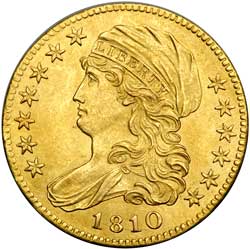 |
1810. Small Date, Large 5 BD-1 Rarity 3+. PCGS graded MS-64. A splendid example, well struck on a problem-free planchet and loaded with intense frosty mint luster. One of the finest graded of this popular date and variety, with only 4 others in the PCGS census in MS64, this one has glorious warm shades of toning over copious amounts of mint bloom. Rim denticles are pretty much intact, and no sign of the oft-seen adjustment marks. It is easy to see this piece was delivered a hard blow by the dies on the early, hand-operated screw press; the dies were accurately aligned and the coin carefully handled after minting, all of which left the coin in its choice, near pristine state of preservation. Rarely are the early Half Eagles found in such a lovely Mint State condition, since most circulated. To locate a near gem is quite unusual.
BD-1 of 1810 pairs an obverse die having a small date to a reverse with tall 5 in the denomination. Rarity-3+ with possibly 150 to 225 known in all grades. As indicated in the Census numbers, there are very few left in this sterling condition, however: Pop 5; 2 finer in 65 (PCGS # 8106) .
Estimated Value $30,000 - 35,000.
Ex: Purchased from Abner Kreisberg in the late 1960's The Del Valle Collection.
View details and enlarged photos
Check results on similar lots
| Realized
$51,700 |
Lot 1769 |
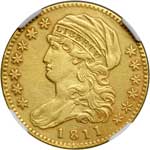 |
1811. NGC grade XF Details, Edge Repaired, Cleaned. Mostly untoned. Only 99,581 struck.
Estimated Value $1,000 - 1,100.
View details and enlarged photos
| Realized
$2,468 |
Lot 1770 |
 |
1811. Tall 5 BD-1 Rarity 3+. PCGS graded MS-63. Boldly struck and frosty with natural greenish-golden hues and hints of rose color toning scattered about. Struck on a problem free planchet. The Capped Bust Left Half Eagle debuted in 1807 nearly six months to the day after the Mint hired John Reich as Assistant Engraver. Reich's design, which also made its first appearance on the Half Dollar that year, was innovative for the United States Mint in that it marked the first inclusion of the denomination on the face of silver and gold coins. (Prior to this, half dollars and silver dollars had their indication of value impressed into the edge lettering.) In his 1988 Encyclopedia, Walter Breen opines that only about 1% of the original mintages in the Capped Bust Left Half Eagle series are extant today. He further states that, "Unlike later gold coins, the vast majority of specimens of this design will grade Extremely Fine or About Unc." It is significant, then, that this 1811 example is in a choicer level of Mint condition, MS63 to be precise. And it is even more significant that the surfaces have been preserved carefully enough to have secured this level from one of the primary grading services.
The Philadelphia Mint employed two different die marriages to deliver 99,581 Half Eagles in 1811. The present variety with a Tall 5 in the reverse denomination is a bit rarer than its Small 5 counterpart. Dannreuther suggests there are about 175 to 250 known in all grades (Rarity-3+ by his estimation).
This impressive, yellow-gold example displays even tones on both sides. Satiny mint luster adds its sheen, and some frosty tendencies to the texture. Free of both bothersome striking incompleteness and all but a few wispy grazes, this coin is perhaps the ideal Type buyer�s Capped Bust Left Half Eagle. A worthy offering for the advanced numismatist; a coin that is sure to elicit nods of approval when it appears at auction. Pop 13; 7 finer, 5 in 64, 1 in 65, 1 in 66 (PCGS # 8110) .
Estimated Value $17,000 - 19,000.
The Del Valle Collection.
View details and enlarged photos
Check results on similar lots
| Realized
$25,263 |
Lot 1771 |
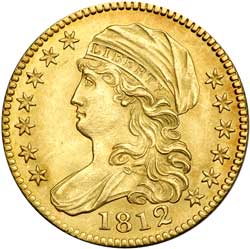 |
1812 BD-1 Rarity 3. PCGS graded MS-64. Wide 5 D variety, and one of only two die pairings used to strike this year's mintage. Mostly well struck on a problem free planchet and sparkling with frosty mint luster. Hints of delicate rose color toning hugs portions of the borders. A high condition example, with realitively few finer graded by PCGS. Extremely well struck on the obverse, in fact definitive in this regard; the reverse strike is crisp in most areas near the rim, though some lack of detail may be noted at the eagle. Highly lustrous, and very desirable. An exceptional example from the standpoint of striking, luster, and eye appeal. As such this is not an ordinary MS64 1812 Half Eagle, but is special. Pop 41; 7 finer, 1 in 64+, 5 in 65, 1 in 66 (PCGS # 8112) .
Die Notes: Approximately 300 to 450 known, indicating Rarity-3 level. This is by far the most common of the two varieties of 1812; the wealthy numismatic scholar and researcher, Harry Bass owned four examples of this combination! The only time this reverse is used, 5 and D strangely separated, as the D is about centered between the 5 and the last A of AMERICA. On the Close 5D that is paired with this obverse to create the second (and last) variety of this type, they are normally spaced.
There also are two curious die lanes seen on the reverse of many coins of this variety (and visible here). They may be graver's marks or some other "injury" to the die. One begins at the rim about two o'clock, passes to the left of A(MERICA), and ends in the wing. The other is curved through the horizontal shield lines and ends in the left wing.
Estimated Value $25,000 - 30,000.
The Del Valle Collection.
View details and enlarged photos
Check results on similar lots
| Realized
$37,600 |
|
|